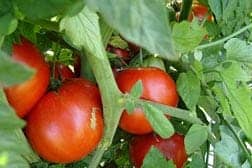A U.S. Department of Agriculture (USDA) chemist in Florida has found a way to help tomato producers improve the taste of their tomatoes. The process is simple—just immerse them briefly in warm water to heat them.
Tomatoes are often picked green and then stored at low temperatures during and after transport to slow ripening. They are then ripened at about 68 °F before being placed on store shelves. That process makes them easier to ship and extends their shelf life. Jinhe Bai, who is with the USDA’s Agricultural Research Service (ARS) in Fort Pierce, wondered if the chilling was why “supermarket tomatoes” often taste bland. ARS is USDA’s chief intramural scientific research agency.
Bai and his colleagues harvested 120 standard “Florida 47” variety tomatoes and subjected 30 tomatoes each to one of four treatments: applying heat only, chilling (to the industry standard of 41 °F), heating prior to chilling, and keeping them at room temperature (controls). For the heat treatment, the tomatoes were placed in 125 °F water for 5 minutes. Like commercially produced tomatoes, tomatoes in the study were ripened at 68 °F after being exposed to the temperature treatments.
Samples of each group were cut and placed into sealed containers. The containers were opened less than an hour later, and the tomatoes were rated for flavor by 21 volunteers, based on the aromas released. The study was designed to evaluate fruit aroma so only the odors were assessed to eliminate bias from taste and “mouth feel.” The researchers also used gas chromatography-mass spectrometry to identify levels of 12 key volatile aroma compounds known to give tomatoes their flavor.
The results show that applying the heat treatment to mature green tomatoes, before they are chilled and shipped, stemmed the loss of several flavor volatiles known to give fruity and floral scents to foods as diverse as citrus and saffron. The heated-then-chilled tomatoes also had more flavor volatiles than the tomatoes that were only chilled: 14 out of 21 panelists could detect more tomato aroma.
It doesn’t help to heat and chill a ripe tomato purchased off a store shelf, Bai says. The heating and chilling process should be applied when the tomatoes are still green. But the treatment does benefit tomatoes that are first beginning to turn red, which is known as their “breaker stage.” The study was published online in LWT-Food Science Technology in January 2015. Read more about this research in the May 2015 issue of AgResearch magazine.


